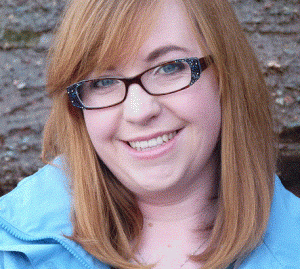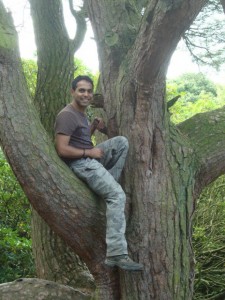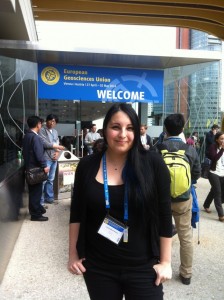We are back! After a few weeks without posting, we thought it was about time we blogged! I have a HUGE backlog of 10 minute interviews that I have to transcribe from EGU 2014. The General Assembly was a great place to meet lots of young scientists doing all sorts of diverse and extremely interesting research. I’ve already posted a couple of interviews I carried out at EGU 2014 (you can read the one with Cindy Mora Stock here and the one with Young Scientist Representative Sam Illingworth here), but there are many more to come.
Today is the first of those! I had the huge pleasure of meeting the lovely Hazel Gibson at EGU. We’d ‘met’ on twitter and I was a huge fan of the content she shares on the social media platform. A girl after my own heart, she is big into science communication and outreach :)! Talking to her was fascinating, her research is focused on the up and coming discipline of geocognition which is how people perceive and understand Earth Sciences. Think psychology meets Earth Science. Importantly, it explores how your background (are you a knowledgeable audience, e.g. a geology researcher, or a non-expert. e.g. a member of the public) affects how you perceive the importance and relevance of Earth Sciences. I wasn’t able to attend Hazel’s talk at the conference, which was hugely disappointing, so I can’t give you more details. However, if you are keen to learn more, Hazel’s excellent blog is a good place to start!
- You are: Hazel Gibbson
- You work at: Plymouth University
- Your role is: PhD – 2nd Year.
Q1) What are you currently working on?
I study what people understand about geology, from a psychology perspective: known as geocognition. It combines geology and psychology by looking at how different audiences understand Earth Sciences. A key point is, how do professionals, academics and the public (including policy makers and teachers – it s a broad audience and can be broadly divided between an expert/non-expert audience) communicate and perceive Earth Sciences.
Q2) What is a typical day like for you?
My time is mostly spent in the office; I spend a lot of time interviewing participants and transcribing interviews. I have to construct the interview results into a visual interpretation of what is in interviewees head. In a sense, I have to try and create a model of what they are thiking. I also spend a lot of time working on outreach at the university. I have recently been involved with the Lyme Regis fossil festival. To take part in that I’m having to travel straight from EGU to festival.
Q3) Can you provide a brief insight into the main findings of your recent paper/research?
I am presenting an oral presentation at the EGU 2014 Assembly on Public Perceptions of geology. At the moment geosciences literacy models are used to build communication, if any models exist at all. But initial findings suggest that they don’t go far enough when comparing expert and non-expert perception of Earth Sciences because they are too logical and simplistic. When compared to a public model you get a lot of differences, not necessarily because the public’s model is wrong but because they haven’t had the training, so their mental models are different and structured differently, so it is misleading to think they are not logical.
Q4) What has been the highlight of your career so far? And as an early stage researcher where do you see yourself in a few years time?
I attended the unconventional gas conference and won a prize for her poster! This was a great achievement because the conference was mainly Industry lead. Presenting a poster on public perceptions of the subsurface to such a technically audience and wining a prize for it was very rewarding.
I would like to continue researching this field because it is a growing field. There is currently, lots of discussion from geoscientist about the importance of public understanding of Earth Sciences but not very much formal research. This means there are lots of avenues you can go down in this field, such as teaching. In the future I see myself teaching at Universities.
Q6) To what locations has your research taken you and why?
My research based in South west of the U.K. so I spend a lot of time in Devon & Cornwall particularly. These areas were chosen for my research due to there being a strong historical geology link, as the area used to be heavily mined and there are lots mining traditions which still remain. An interesting question I am trying to address is how does the cultural identity affects people’s perceptions of Earth Science?.
Q7) What is your highlight of attending the EGU 2014 Assembly?
The highlight of the Assembly is being able to meet other young researchers. You get very isolated as a PhD student. As an interdisciplinary student I often feel like strange, like I don’t belong to either research community my work sits within and that can lead me to think my problems are very much my own. The Assembly gives me the opportunity to meet and talk to people who are also doing interdisciplinary PhD. It’s nice to know there are people who are in the same boat as me.
Q8) If you could invent an element, what would it be called and what would it do?
Unobtanium – mineral that is in all the films. Solves the energy crisis and create clean fuel and clean itself up! It would probably glow as well.
Hazel undertook her undergraduate degree in physical geography with geology at Plymouth University. She then moved to Masters in hazard assessment, at Portsmouth University. Her first job was as an engineering geologist in Brisbane. The position gave her the opportunity to save lots of money, which allowed her to move onto a working as a volunteer in Mt St Helen’s as a ranger for a season. This role gave Hazel her first taste of public engagement and she enjoyed it so much she realised this was the career for her. After her time at Mt St. Helen’s she went onto the Natural History Museum in London and worked as a science educator and then moved onto a role as an Earth Science Identification Officer – identified what people sent in! She us now back at Plymouth University completing her PhD.
If you’d like to get in touch with Hazel you can reach her on email or twitter.





